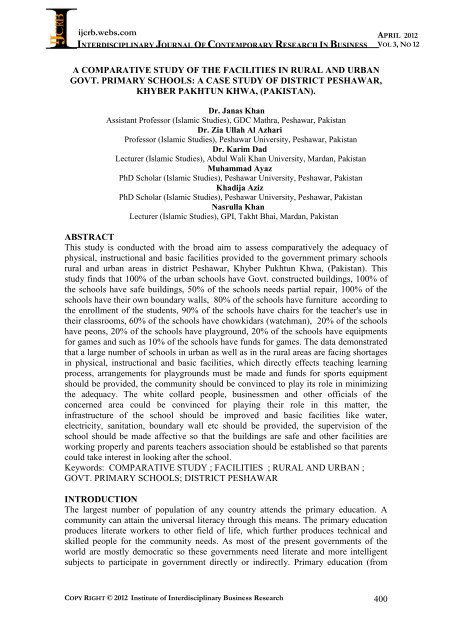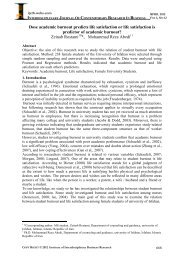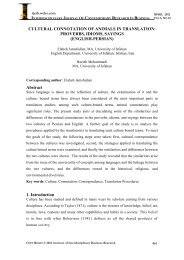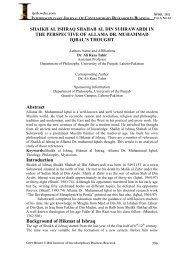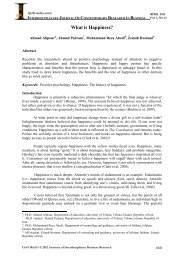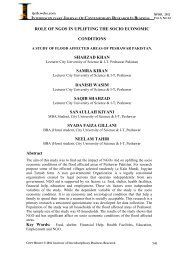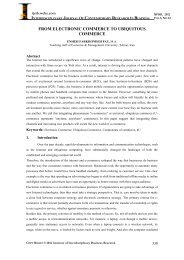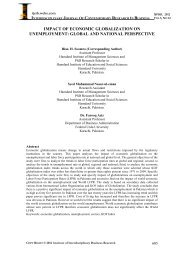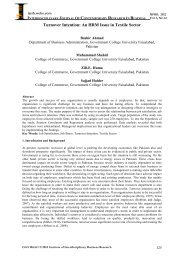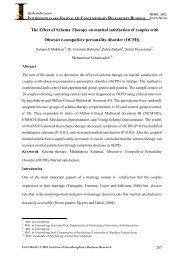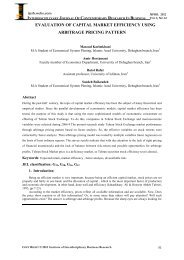a comparative study of the facilities in rural and urban - journal ...
a comparative study of the facilities in rural and urban - journal ...
a comparative study of the facilities in rural and urban - journal ...
Create successful ePaper yourself
Turn your PDF publications into a flip-book with our unique Google optimized e-Paper software.
ijcrb.webs.com<br />
INTERDISCIPLINARY JOURNAL OF CONTEMPORARY RESEARCH IN BUSINESS<br />
APRIL 2012<br />
VOL 3, NO 12<br />
A COMPARATIVE STUDY OF THE FACILITIES IN RURAL AND URBAN<br />
GOVT. PRIMARY SCHOOLS: A CASE STUDY OF DISTRICT PESHAWAR,<br />
KHYBER PAKHTUN KHWA, (PAKISTAN).<br />
Dr. Janas Khan<br />
Assistant Pr<strong>of</strong>essor (Islamic Studies), GDC Mathra, Peshawar, Pakistan<br />
Dr. Zia Ullah Al Azhari<br />
Pr<strong>of</strong>essor (Islamic Studies), Peshawar University, Peshawar, Pakistan<br />
Dr. Karim Dad<br />
Lecturer (Islamic Studies), Abdul Wali Khan University, Mardan, Pakistan<br />
Muhammad Ayaz<br />
PhD Scholar (Islamic Studies), Peshawar University, Peshawar, Pakistan<br />
Khadija Aziz<br />
PhD Scholar (Islamic Studies), Peshawar University, Peshawar, Pakistan<br />
Nasrulla Khan<br />
Lecturer (Islamic Studies), GPI, Takht Bhai, Mardan, Pakistan<br />
ABSTRACT<br />
This <strong>study</strong> is conducted with <strong>the</strong> broad aim to assess <strong>comparative</strong>ly <strong>the</strong> adequacy <strong>of</strong><br />
physical, <strong>in</strong>structional <strong>and</strong> basic <strong>facilities</strong> provided to <strong>the</strong> government primary schools<br />
<strong>rural</strong> <strong>and</strong> <strong>urban</strong> areas <strong>in</strong> district Peshawar, Khyber Pukhtun Khwa, (Pakistan). This<br />
<strong>study</strong> f<strong>in</strong>ds that 100% <strong>of</strong> <strong>the</strong> <strong>urban</strong> schools have Govt. constructed build<strong>in</strong>gs, 100% <strong>of</strong><br />
<strong>the</strong> schools have safe build<strong>in</strong>gs, 50% <strong>of</strong> <strong>the</strong> schools needs partial repair, 100% <strong>of</strong> <strong>the</strong><br />
schools have <strong>the</strong>ir own boundary walls, 80% <strong>of</strong> <strong>the</strong> schools have furniture accord<strong>in</strong>g to<br />
<strong>the</strong> enrollment <strong>of</strong> <strong>the</strong> students, 90% <strong>of</strong> <strong>the</strong> schools have chairs for <strong>the</strong> teacher's use <strong>in</strong><br />
<strong>the</strong>ir classrooms, 60% <strong>of</strong> <strong>the</strong> schools have chowkidars (watchman), 20% <strong>of</strong> <strong>the</strong> schools<br />
have peons, 20% <strong>of</strong> <strong>the</strong> schools have playground, 20% <strong>of</strong> <strong>the</strong> schools have equipments<br />
for games <strong>and</strong> such as 10% <strong>of</strong> <strong>the</strong> schools have funds for games. The data demonstrated<br />
that a large number <strong>of</strong> schools <strong>in</strong> <strong>urban</strong> as well as <strong>in</strong> <strong>the</strong> <strong>rural</strong> areas are fac<strong>in</strong>g shortages<br />
<strong>in</strong> physical, <strong>in</strong>structional <strong>and</strong> basic <strong>facilities</strong>, which directly effects teach<strong>in</strong>g learn<strong>in</strong>g<br />
process, arrangements for playgrounds must be made <strong>and</strong> funds for sports equipment<br />
should be provided, <strong>the</strong> community should be conv<strong>in</strong>ced to play its role <strong>in</strong> m<strong>in</strong>imiz<strong>in</strong>g<br />
<strong>the</strong> adequacy. The white collard people, bus<strong>in</strong>essmen <strong>and</strong> o<strong>the</strong>r <strong>of</strong>ficials <strong>of</strong> <strong>the</strong><br />
concerned area could be conv<strong>in</strong>ced for play<strong>in</strong>g <strong>the</strong>ir role <strong>in</strong> this matter, <strong>the</strong><br />
<strong>in</strong>frastructure <strong>of</strong> <strong>the</strong> school should be improved <strong>and</strong> basic <strong>facilities</strong> like water,<br />
electricity, sanitation, boundary wall etc should be provided, <strong>the</strong> supervision <strong>of</strong> <strong>the</strong><br />
school should be made affective so that <strong>the</strong> build<strong>in</strong>gs are safe <strong>and</strong> o<strong>the</strong>r <strong>facilities</strong> are<br />
work<strong>in</strong>g properly <strong>and</strong> parents teachers association should be established so that parents<br />
could take <strong>in</strong>terest <strong>in</strong> look<strong>in</strong>g after <strong>the</strong> school.<br />
Keywords: COMPARATIVE STUDY ; FACILITIES ; RURAL AND URBAN ;<br />
GOVT. PRIMARY SCHOOLS; DISTRICT PESHAWAR<br />
INTRODUCTION<br />
The largest number <strong>of</strong> population <strong>of</strong> any country attends <strong>the</strong> primary education. A<br />
community can atta<strong>in</strong> <strong>the</strong> universal literacy through this means. The primary education<br />
produces literate workers to o<strong>the</strong>r field <strong>of</strong> life, which fur<strong>the</strong>r produces technical <strong>and</strong><br />
skilled people for <strong>the</strong> community needs. As most <strong>of</strong> <strong>the</strong> present governments <strong>of</strong> <strong>the</strong><br />
world are mostly democratic so <strong>the</strong>se governments need literate <strong>and</strong> more <strong>in</strong>telligent<br />
subjects to participate <strong>in</strong> government directly or <strong>in</strong>directly. Primary education (from<br />
COPY RIGHT © 2012 Institute <strong>of</strong> Interdiscipl<strong>in</strong>ary Bus<strong>in</strong>ess Research 400
ijcrb.webs.com<br />
INTERDISCIPLINARY JOURNAL OF CONTEMPORARY RESEARCH IN BUSINESS<br />
APRIL 2012<br />
VOL 3, NO 12<br />
class 1-5) be<strong>in</strong>g <strong>the</strong> first <strong>and</strong> basic stage <strong>of</strong> education enable people learn read<strong>in</strong>g,<br />
writ<strong>in</strong>g <strong>and</strong> simple arithmetic. Be<strong>in</strong>g <strong>the</strong> <strong>in</strong>itial stage <strong>and</strong> a base for fur<strong>the</strong>r education it<br />
needs high concentration.<br />
In <strong>the</strong> field <strong>of</strong> economic development <strong>of</strong> a country human resource is <strong>of</strong> great<br />
importance. When a country uses her full human resources she develops rapidly. The<br />
socio economic situations <strong>in</strong> Pakistan also manifest a sorry state. Pakistan st<strong>and</strong>s at<br />
138th number out <strong>of</strong> 188 countries <strong>and</strong> is <strong>the</strong> fifth populated country among South<br />
Asian Countries. Pakistan is <strong>in</strong> 6th number <strong>in</strong> 7 SAARC countries <strong>and</strong> is better than<br />
Nepal only. The Human Development Index (HDI) <strong>of</strong> United Nation denotes Pakistan<br />
as a third most illiterate country <strong>in</strong> <strong>the</strong> world.<br />
At <strong>the</strong> time <strong>of</strong> <strong>in</strong>dependence about 90 % <strong>of</strong> our population was illiterate with only a<br />
h<strong>and</strong>ful <strong>of</strong> educational <strong>in</strong>stitutions.<br />
(“Problems <strong>of</strong> Education <strong>in</strong> Pakistan” By Nasim J.Q. 2002).<br />
The first educational conference <strong>of</strong> Pakistan which was held <strong>in</strong> Karachi <strong>in</strong> November<br />
1947 shortly after Pakistan’s creation, Quid-e-Azam <strong>in</strong> his message to it, provided<br />
guidel<strong>in</strong>es for our educational system. It mentioned <strong>the</strong>re is no doubt that <strong>the</strong> future <strong>of</strong><br />
our state will <strong>and</strong> must greatly depend upon <strong>the</strong> type <strong>of</strong> education we give to our<br />
children, <strong>and</strong> <strong>the</strong> way <strong>in</strong> which we br<strong>in</strong>g <strong>the</strong>m up as future citizens <strong>of</strong> Pakistan.<br />
Education does not merely mean academic education. There is immediate <strong>and</strong> urgent<br />
need for giv<strong>in</strong>g scientific <strong>and</strong> technical education to our people <strong>in</strong> order to build up our<br />
future economic life <strong>and</strong> to see that our people take <strong>the</strong> science, commerce, trade <strong>and</strong><br />
particularly was planned <strong>in</strong>dustries. We should not forget that we have to compete with<br />
<strong>the</strong> world, which is mov<strong>in</strong>g very fast <strong>in</strong> this direction (Tanvir 1998). Although our<br />
literacy rate has improved <strong>comparative</strong>ly but even <strong>the</strong>n we cannot compete many<br />
countries <strong>of</strong> <strong>the</strong> world as we could not succeed <strong>in</strong> tak<strong>in</strong>g our literacy rate to hundred.<br />
Especially <strong>the</strong> <strong>rural</strong> areas <strong>of</strong> our country present a horrible picture <strong>of</strong> low literacy rate.<br />
Accord<strong>in</strong>g to <strong>the</strong> Economic Survey <strong>of</strong> Pakistan (2007-08), literacy rate <strong>in</strong> technological<br />
advanced countries is almost 100%, but <strong>in</strong> less developed countries is not like that.<br />
Almost two decades ago literacy rate <strong>of</strong> Pakistan was only 34% (age 10 <strong>and</strong> above).<br />
Population census 1972 <strong>and</strong> 1981 data <strong>in</strong>dicates that <strong>in</strong> <strong>the</strong> 1960s <strong>and</strong> 1970s, literacy<br />
rate improved by 0.5 % per year. Although <strong>the</strong> 1998 Census revealed a growth rate <strong>of</strong><br />
1.07% per year dur<strong>in</strong>g 1981 to 1998 when <strong>the</strong> literacy rate (10 years <strong>and</strong> above) <strong>of</strong><br />
population rose from 26.2% to 43.9%. Such as <strong>in</strong> <strong>the</strong> current decade, <strong>the</strong> four <strong>in</strong>dicators<br />
like Literacy rate, Enrollment Rate, Gross Enrollment Rate <strong>and</strong> Net Enrollment Rate<br />
have at a reasonable pace.<br />
In fact, at <strong>the</strong> primary level sound <strong>in</strong>crease occurred <strong>in</strong> <strong>the</strong> Gross Enrolment Ratio <strong>and</strong><br />
recorded 71% <strong>in</strong> 2001-02 <strong>and</strong> 84% <strong>in</strong> 2005-06. Primary school Net Enrolment Ratio<br />
(NER) <strong>in</strong>creased from 57% <strong>in</strong> 2001-02 to 66% <strong>in</strong> 2005-06. Such as contribution at <strong>the</strong><br />
secondary school level has also enhanced <strong>and</strong> <strong>the</strong> GER <strong>and</strong> <strong>the</strong> NER <strong>in</strong>creased<br />
respectively, from <strong>the</strong>ir levels <strong>in</strong> 2001-02 <strong>of</strong> 24% <strong>and</strong> 20%, to reach 31% <strong>and</strong> 24%.<br />
Fur<strong>the</strong>r, enrolment ratio <strong>in</strong> tertiary education, which was 2.5% dur<strong>in</strong>g 1999- 2000, rose<br />
significantly to its 3.7% level <strong>in</strong> 2005-06. If compared performance <strong>of</strong> primary<br />
COPY RIGHT © 2012 Institute <strong>of</strong> Interdiscipl<strong>in</strong>ary Bus<strong>in</strong>ess Research 401
ijcrb.webs.com<br />
INTERDISCIPLINARY JOURNAL OF CONTEMPORARY RESEARCH IN BUSINESS<br />
APRIL 2012<br />
VOL 3, NO 12<br />
education with neighbors countries it is not desirable as <strong>the</strong> figures demonstrated that<br />
Pakistan’s adult literacy rate (49.9%) is lower than <strong>the</strong> rate for countries like Sri Lanka<br />
(90.7%), Iran (82.4%), Indonesia (90.4%), Vietnam (90.3%), Egypt (71.4%) <strong>and</strong> India<br />
(61%) for 2004-05 (Govt. <strong>of</strong> Pakistan, 2009). Accord<strong>in</strong>g to an estimate <strong>in</strong> NWFP <strong>the</strong>re<br />
are almost 75,000 teachers engaged <strong>in</strong> primary education. Akhtar (2009), North West<br />
Frontier Prov<strong>in</strong>ce (NWFP) Education Department, <strong>in</strong> partnership with United States<br />
Agency for International Development (USAID), has decided to launch second shift <strong>in</strong><br />
primary schools, particularly for women, <strong>in</strong> public sector’s middle <strong>and</strong> high schools’<br />
build<strong>in</strong>gs <strong>in</strong> <strong>the</strong> entire prov<strong>in</strong>ce.<br />
STATEMENT OF THE PROBLEM<br />
The problem <strong>of</strong> <strong>the</strong> <strong>study</strong> is to assess <strong>comparative</strong>ly Physical, Instructional <strong>and</strong> Basic<br />
Facilities provided to Government Primary Schools for Boys <strong>in</strong> Rural <strong>and</strong> Urban areas<br />
<strong>in</strong> District Peshawar.<br />
DELIMITATION OF THE STUDY<br />
Peshawar is <strong>the</strong> capital city <strong>of</strong> NWFP. The entire district is very large <strong>and</strong> thickly<br />
populated. The total area comprises 1257 square kilometers. The total numbers <strong>of</strong> Govt.<br />
Primary Schools for boys <strong>in</strong> district Peshawar is 691 <strong>in</strong> which 487 are <strong>in</strong> <strong>urban</strong> areas<br />
while 207 <strong>in</strong> <strong>rural</strong> areas. Thus it is difficult for <strong>the</strong> researcher to cover all <strong>the</strong> schools so<br />
out <strong>of</strong> <strong>the</strong>se 40 Government primary schools for boys have r<strong>and</strong>omly been selected 20<br />
from <strong>urban</strong> <strong>and</strong> 20 from <strong>rural</strong> areas.<br />
As <strong>the</strong> <strong>study</strong> is about <strong>the</strong> comparison <strong>of</strong> physical, <strong>in</strong>structional <strong>and</strong> basic <strong>facilities</strong><br />
provided to Govt. primary schools for boys <strong>in</strong> Urban <strong>and</strong> Rural areas so <strong>the</strong> researcher<br />
<strong>in</strong>tends to focus his research on it.<br />
OBJECTIVES OF THE STUDY<br />
The ma<strong>in</strong> objectives <strong>of</strong> this paper are given below:<br />
i. Physical, <strong>in</strong>structional <strong>and</strong> basic <strong>facilities</strong> ( it <strong>in</strong>cludes <strong>the</strong> condition <strong>of</strong> school<br />
build<strong>in</strong>g, classrooms, space <strong>in</strong> <strong>the</strong> classrooms for students , furniture <strong>and</strong><br />
equipments, dr<strong>in</strong>k<strong>in</strong>g water <strong>and</strong> basic amenities <strong>in</strong> <strong>the</strong> schools.<br />
ii. To analyze <strong>the</strong> policy <strong>and</strong> <strong>in</strong>itiatives <strong>of</strong> provisional government on<br />
universalization <strong>of</strong> primary education <strong>in</strong> <strong>the</strong> region <strong>in</strong> context <strong>of</strong> provid<strong>in</strong>g<br />
physical <strong>facilities</strong>, <strong>in</strong>structional materials, o<strong>the</strong>r basic necessities <strong>and</strong> rais<strong>in</strong>g <strong>the</strong><br />
pr<strong>of</strong>essional competence <strong>of</strong> teachers.<br />
iii. To make some suggestions <strong>in</strong> he light <strong>of</strong> <strong>the</strong> f<strong>in</strong>d<strong>in</strong>gs <strong>of</strong> <strong>the</strong> <strong>study</strong>.<br />
LITERATURE REVIEW<br />
Although all <strong>the</strong> steps <strong>of</strong> research are very important, <strong>the</strong> review <strong>of</strong> related literature has<br />
a vital position <strong>in</strong> research process; it beg<strong>in</strong>s after <strong>the</strong> selection <strong>and</strong> statement <strong>of</strong> <strong>the</strong><br />
problem. In review <strong>of</strong> related literature <strong>the</strong> research identify, locate <strong>and</strong> analyze <strong>the</strong><br />
related literature <strong>in</strong>volves <strong>the</strong> systematic identification, location <strong>and</strong> analysis <strong>of</strong><br />
document conta<strong>in</strong><strong>in</strong>g <strong>in</strong>formation related to <strong>the</strong> research problem.<br />
COPY RIGHT © 2012 Institute <strong>of</strong> Interdiscipl<strong>in</strong>ary Bus<strong>in</strong>ess Research 402
ijcrb.webs.com<br />
INTERDISCIPLINARY JOURNAL OF CONTEMPORARY RESEARCH IN BUSINESS<br />
APRIL 2012<br />
VOL 3, NO 12<br />
The Concept <strong>of</strong> Education <strong>in</strong> <strong>the</strong> Views <strong>of</strong> Various Scholars<br />
The word "Education" has been derived from <strong>the</strong> Lat<strong>in</strong> words educare, educere or<br />
educatum which mean "to tra<strong>in</strong>, to br<strong>in</strong>g up <strong>and</strong> to lead out”, so to tra<strong>in</strong> <strong>and</strong> lead out <strong>the</strong><br />
<strong>in</strong>ner potentialities <strong>of</strong> an <strong>in</strong>dividual is called Education (Tanvir, 1998).<br />
Education has been def<strong>in</strong>ed <strong>in</strong> various ways. Some scholars def<strong>in</strong>e Education as.<br />
Accord<strong>in</strong>g to Imam Ghazali:"A process which enable an <strong>in</strong>dividual to dist<strong>in</strong>guish<br />
between <strong>the</strong> true <strong>and</strong> <strong>the</strong> false, <strong>the</strong> good <strong>and</strong> <strong>the</strong> bad, <strong>the</strong> right conduct <strong>and</strong> <strong>the</strong> evil<br />
do<strong>in</strong>g".<br />
Ghazali Imam. Ahya ul Uloom. 2004 dar ul ahya atturat alilmi. Berut. Labnon<br />
Ibne-Khaldun def<strong>in</strong>es education <strong>in</strong> <strong>the</strong>se words: "Education consists <strong>of</strong> <strong>the</strong> <strong>in</strong>tellectual<br />
<strong>and</strong> normal tra<strong>in</strong><strong>in</strong>g <strong>of</strong> <strong>the</strong> mank<strong>in</strong>d through which <strong>the</strong>ir hidden potentialities are<br />
developed, traits <strong>of</strong> character are built, <strong>the</strong> knowledge <strong>and</strong> culture <strong>of</strong> <strong>the</strong> people is<br />
conveyed to <strong>the</strong> com<strong>in</strong>g generations".<br />
Ibne Khuldun. Ahya ul Uloom. 2000 dar ul ahya atturat alilmi. Berut. Labnon<br />
"Education is develop<strong>in</strong>g <strong>the</strong> body <strong>and</strong> <strong>the</strong> soul <strong>of</strong> all <strong>the</strong> perfection which <strong>the</strong>y are<br />
capable <strong>of</strong> ". (Plato) Education, Tariq Pervaiz khan, 2007.Majeed book depot.<br />
Urdu bazar Lahore.<br />
Accord<strong>in</strong>g to John Dewey (1916), "Education is <strong>the</strong> development <strong>of</strong> all those capacities<br />
<strong>in</strong> <strong>the</strong> <strong>in</strong>dividuals which enables him to control his environment <strong>and</strong> fulfill his<br />
responsibilities".<br />
Needs <strong>and</strong> Importance <strong>of</strong> Education <strong>in</strong> Islam<br />
Emphasiz<strong>in</strong>g <strong>the</strong> importance <strong>of</strong> education <strong>and</strong> learn<strong>in</strong>g <strong>in</strong> Islam it is enough to note that<br />
<strong>the</strong> first revelation <strong>of</strong> <strong>the</strong> prophet (PBUH) was read <strong>in</strong> <strong>the</strong> name <strong>of</strong> Lord. Allah has<br />
clearly bestowed on men <strong>the</strong> gift <strong>of</strong> knowledge. The Holy Quran at a number <strong>of</strong> places<br />
stresses on <strong>the</strong> observation <strong>of</strong> <strong>the</strong> universe <strong>and</strong> nature. In a place at Surah Taha "Allah<br />
address<strong>in</strong>g <strong>the</strong> prophet enjo<strong>in</strong>s him to pray for <strong>the</strong> advancement <strong>of</strong> knowledge"(Surah<br />
Taha.Ayat. 114). The prophet (PBUH) highly valued education. He says, "Seek<br />
knowledge even if it is <strong>in</strong> Ch<strong>in</strong>a". (Al-Hadith)."The scholars <strong>and</strong> <strong>the</strong> students are <strong>the</strong><br />
best <strong>of</strong> human be<strong>in</strong>gs.(Al-Hadith). At ano<strong>the</strong>r place <strong>the</strong> Holy prophet has said <strong>and</strong><br />
"Learned are <strong>the</strong> heirs <strong>of</strong> prophets" (Al-Hadith)."Acquisition <strong>of</strong> knowledge is obligatory<br />
upon every Muslim Man <strong>and</strong> Woman".(Al-Hadit)}. He even acknowledged <strong>the</strong><br />
importance <strong>of</strong> travel<strong>in</strong>g <strong>in</strong> enrich<strong>in</strong>g one's experience <strong>and</strong> advised all Muslim Men <strong>and</strong><br />
Women to acquire knowledge if it is available even <strong>in</strong> far -<strong>of</strong>f places. And imam-ebukhari<br />
traveled for months <strong>in</strong> search <strong>of</strong> only one hadith.<br />
Primary Education <strong>in</strong> <strong>the</strong> Light <strong>of</strong> Various Educational Policies<br />
With <strong>the</strong> view to reform <strong>the</strong> education system <strong>of</strong> <strong>the</strong> country, an All Pakistan Education<br />
Conference was called upon right three months after <strong>the</strong> <strong>in</strong>dependence <strong>of</strong> <strong>the</strong> country.<br />
Founder <strong>of</strong> <strong>the</strong> nation Quaid-e-Azam Muhammad Ali J<strong>in</strong>nah was <strong>the</strong> chairman. Despite<br />
<strong>the</strong> turmoil country was pass<strong>in</strong>g through as a newly born one, he put forward three<br />
suggestions.<br />
COPY RIGHT © 2012 Institute <strong>of</strong> Interdiscipl<strong>in</strong>ary Bus<strong>in</strong>ess Research 403
ijcrb.webs.com<br />
INTERDISCIPLINARY JOURNAL OF CONTEMPORARY RESEARCH IN BUSINESS<br />
APRIL 2012<br />
VOL 3, NO 12<br />
<br />
<br />
<br />
Compulsory primary education.<br />
5-4 years free primary education with slow extension <strong>in</strong> its duration up to eight<br />
years.<br />
Equality <strong>in</strong> access to education <strong>of</strong> girls <strong>and</strong> boys.<br />
The second educational conference held <strong>in</strong> 1951 was mostly a repetition <strong>of</strong> <strong>the</strong> first one<br />
but <strong>the</strong>se two conferences proved to be <strong>the</strong> l<strong>and</strong> mark <strong>in</strong> <strong>the</strong> history <strong>of</strong> education <strong>in</strong><br />
Pakistan <strong>and</strong> <strong>the</strong> next 6 years plan was prepared <strong>in</strong> <strong>the</strong> light <strong>of</strong> <strong>the</strong> suggestions put<br />
forward by <strong>the</strong>m.<br />
The National Educational Policy 1998-2010:<br />
A number <strong>of</strong> educational policies were made before <strong>the</strong> policy <strong>of</strong> 1998- 2010.Each <strong>and</strong><br />
every one <strong>of</strong> <strong>the</strong>m holds its own significance. Some <strong>of</strong> <strong>the</strong>m were based on reconstruction,<br />
some based on re-orientation, some on mobilization base etc. The policy<br />
<strong>of</strong> 1998–2010 among all <strong>the</strong> previous policies st<strong>and</strong>s prom<strong>in</strong>ent as it was designed on<br />
<strong>the</strong> image <strong>of</strong> <strong>the</strong> 21st century. The new century has its own needs. The world has<br />
changed a lot <strong>in</strong> <strong>the</strong> 20th century from its beg<strong>in</strong>n<strong>in</strong>g to <strong>the</strong> last moment. Keep<strong>in</strong>g <strong>the</strong><br />
whole world <strong>in</strong> view <strong>the</strong> educational policy 1998-2010 was designed to fulfill <strong>the</strong><br />
dem<strong>and</strong>s <strong>of</strong> <strong>the</strong> 21st century (Govt <strong>of</strong> Pakistan, 2007).<br />
METHODOLOGY AND DATA COLLECTION<br />
Nature <strong>of</strong> Research<br />
The nature <strong>of</strong> <strong>the</strong> <strong>study</strong> is descriptive. It consists <strong>of</strong> collect<strong>in</strong>g, analyz<strong>in</strong>g <strong>and</strong><br />
<strong>in</strong>terpret<strong>in</strong>g <strong>of</strong> data keep<strong>in</strong>g <strong>in</strong> m<strong>in</strong>d all <strong>the</strong> factors responsible for <strong>the</strong> adequacy <strong>of</strong><br />
physical, <strong>in</strong>structional <strong>and</strong> basic <strong>facilities</strong>. For collection <strong>of</strong> requisite data various<br />
<strong>in</strong>struments like questionnaire <strong>and</strong> <strong>in</strong>terview schedule has been used <strong>in</strong> <strong>the</strong> field.<br />
Rationale <strong>of</strong> <strong>the</strong> Questionnaire<br />
In descriptive type <strong>of</strong> <strong>study</strong> <strong>the</strong> construction <strong>and</strong> use <strong>of</strong> questionnaire <strong>and</strong> <strong>in</strong>terview<br />
schedules are popular to be used for collect<strong>in</strong>g both quantitative <strong>and</strong> qualitative nature<br />
<strong>of</strong> data on <strong>the</strong> subject. A questionnaire constructed with hard work <strong>and</strong> patience will<br />
have advantages <strong>and</strong> would serve as a most appropriate data-ga<strong>the</strong>r<strong>in</strong>g device <strong>in</strong> a<br />
research. Therefore great care has been taken <strong>in</strong> this respect. The questionnaires were<br />
constructed both <strong>in</strong> Urdu <strong>and</strong> English versions, which were used for <strong>the</strong> schools <strong>and</strong> <strong>the</strong><br />
concerned persons <strong>of</strong> <strong>the</strong> department.<br />
Sampl<strong>in</strong>g<br />
Peshawar is <strong>the</strong> capital city <strong>of</strong> NWFP. The entire district is very large <strong>and</strong> thickly<br />
populated. The total area comprises 1257 square kilometers. The total numbers <strong>of</strong> Govt.<br />
Primary Schools for boys <strong>in</strong> district Peshawar is 691 <strong>in</strong> which 487 are <strong>in</strong> <strong>urban</strong> areas<br />
while 207 <strong>in</strong> <strong>rural</strong> areas. Thus it is difficult for <strong>the</strong> researcher to cover all <strong>the</strong> schools<br />
<strong>the</strong>refore 40 Government primary schools for boys have r<strong>and</strong>omly been selected (20<br />
from <strong>urban</strong> <strong>and</strong> 20 from <strong>rural</strong> areas) for research purpose.<br />
COPY RIGHT © 2012 Institute <strong>of</strong> Interdiscipl<strong>in</strong>ary Bus<strong>in</strong>ess Research 404
ijcrb.webs.com<br />
INTERDISCIPLINARY JOURNAL OF CONTEMPORARY RESEARCH IN BUSINESS<br />
APRIL 2012<br />
VOL 3, NO 12<br />
Collection <strong>of</strong> Data<br />
The data for this paper has been collected by <strong>the</strong> researcher personally <strong>and</strong> he has also<br />
been assisted by his friends <strong>and</strong> colleagues <strong>in</strong> <strong>the</strong> collection <strong>of</strong> relevant <strong>in</strong>formation<br />
from <strong>the</strong> government primary schools for boys. The collection <strong>of</strong> data through personal<br />
contact has facilitated <strong>the</strong> researcher to make <strong>the</strong> concept <strong>of</strong> <strong>the</strong> questionnaire clear to<br />
<strong>the</strong> respondent <strong>and</strong> to remove <strong>the</strong>ir difficulties <strong>in</strong> fill<strong>in</strong>g questionnaire on <strong>the</strong> spot. The<br />
personal contact was also useful to discuss <strong>the</strong> problem <strong>and</strong> issues faced by teachers <strong>in</strong><br />
properly utiliz<strong>in</strong>g <strong>and</strong> ma<strong>in</strong>ta<strong>in</strong><strong>in</strong>g <strong>the</strong> <strong>facilities</strong> under <strong>study</strong>. The useful <strong>in</strong>formation on<br />
<strong>the</strong> problem has been <strong>in</strong>corporated <strong>in</strong> <strong>the</strong> <strong>study</strong>.<br />
RESULTS AND DATA ANALAYSIS<br />
The data collected from <strong>the</strong> selected schools is analyzed through questionnaire. The data<br />
regard<strong>in</strong>g to each item or statement is worked out <strong>in</strong> percentage because <strong>the</strong> techniques<br />
<strong>of</strong> percentage are simple <strong>and</strong> feasible to use for this k<strong>in</strong>d <strong>of</strong> <strong>study</strong>. The data is given <strong>in</strong><br />
tables as well as <strong>in</strong> open form.<br />
Table 1 Status <strong>of</strong> <strong>the</strong> Build<strong>in</strong>gs <strong>in</strong> Urban Schools<br />
Number = 20<br />
Description Number Percentage<br />
Govt. Constructed 20 100.00<br />
Build<strong>in</strong>g is safe 20 100.00<br />
Build<strong>in</strong>g is dangerous 00 0.00<br />
It needs repair (partial) 10 50.00<br />
It needs repair (complete) 00 0.00<br />
It has boundary wall 20 100.00<br />
It has ma<strong>in</strong> gate 20 100.00<br />
Source: Field Survey<br />
Table 1 <strong>in</strong>dicates that 100% <strong>of</strong> <strong>the</strong> build<strong>in</strong>gs government constructed <strong>and</strong> are safe.<br />
None <strong>of</strong> <strong>the</strong> build<strong>in</strong>g is <strong>in</strong> dangerous condition. But 50% <strong>of</strong> <strong>the</strong> build<strong>in</strong>gs need<br />
partial repair. None <strong>of</strong> <strong>the</strong> school needs complete repair. 100% <strong>of</strong> <strong>the</strong> schools have<br />
boundary walls <strong>and</strong> school gates, which is very helpful for security.<br />
Table 2 Status <strong>of</strong> <strong>the</strong> Build<strong>in</strong>gs <strong>in</strong> Rural Schools<br />
Number = 20<br />
Description Number Percentage<br />
Govt. Constructed 20 100<br />
Build<strong>in</strong>g is safe 16 80<br />
Build<strong>in</strong>g is dangerous 08 40<br />
It needs repair (partial) 08 40<br />
It needs repair (complete) 00 0.00<br />
It has boundary wall 16 80<br />
It has ma<strong>in</strong> gate 16 80<br />
Source: Field Survey<br />
COPY RIGHT © 2012 Institute <strong>of</strong> Interdiscipl<strong>in</strong>ary Bus<strong>in</strong>ess Research 405
ijcrb.webs.com<br />
INTERDISCIPLINARY JOURNAL OF CONTEMPORARY RESEARCH IN BUSINESS<br />
APRIL 2012<br />
VOL 3, NO 12<br />
Table 2 <strong>in</strong>dicates that 100% <strong>of</strong> <strong>the</strong> build<strong>in</strong>gs government constructed <strong>and</strong> 80% build<strong>in</strong>gs<br />
are safe. 40 <strong>of</strong> <strong>the</strong> build<strong>in</strong>gs are <strong>in</strong> dangerous condition, which needs to be repaired<br />
immediately. But <strong>the</strong> mentioned 40 % <strong>of</strong> <strong>the</strong> build<strong>in</strong>gs need partial repair. None <strong>of</strong> <strong>the</strong><br />
school needs complete repair. 80% <strong>of</strong> <strong>the</strong> schools have boundary walls <strong>and</strong> school gates.<br />
Comparison <strong>of</strong> Table 1 <strong>and</strong> Table 2 Results<br />
100% <strong>of</strong> <strong>the</strong> schools are built by <strong>the</strong> government <strong>in</strong> <strong>urban</strong> as well as <strong>in</strong> <strong>the</strong> <strong>rural</strong> areas.<br />
Same is <strong>the</strong> condition <strong>of</strong> <strong>the</strong> safety <strong>in</strong> <strong>urban</strong> areas while 80% <strong>of</strong> <strong>the</strong> <strong>rural</strong> school<br />
build<strong>in</strong>gs are safe. 50% schools need repair <strong>in</strong> <strong>urban</strong> while 40% schools <strong>in</strong> <strong>the</strong> <strong>rural</strong><br />
areas. 100% schools <strong>in</strong> <strong>urban</strong> <strong>and</strong> 80% schools <strong>in</strong> <strong>the</strong> <strong>rural</strong> areas have <strong>the</strong>ir boundary<br />
walls <strong>and</strong> school gates, which can provide good security measures.<br />
Table 3 Status <strong>of</strong> <strong>the</strong> Furniture <strong>in</strong> Urban Schools<br />
Number = 20<br />
Description Number Percentage<br />
Furniture accord<strong>in</strong>g to enrollment 16 80<br />
Space sufficient accord<strong>in</strong>g to<br />
12 60<br />
student’s enrollment<br />
Have teacher’s chair 18 90<br />
Have chalkboard 20 100<br />
Have cupboard 14 70<br />
Source: Field Survey<br />
Table 3 shows that 80% <strong>of</strong> <strong>the</strong> <strong>urban</strong> schools have furniture accord<strong>in</strong>g to <strong>the</strong><br />
enrollment <strong>of</strong> <strong>the</strong> students. 60% <strong>of</strong> <strong>the</strong> schools have sufficient space accord<strong>in</strong>g to <strong>the</strong><br />
enrollment <strong>of</strong> <strong>the</strong> students.90% have chairs for teachers.100% schools have<br />
chalkboards while 60% have cupboards.<br />
Table 4 Status <strong>of</strong> <strong>the</strong> Furniture <strong>in</strong> Urban Schools<br />
Number = 20<br />
Description Number Percentage<br />
Furniture accord<strong>in</strong>g to enrollment 08 40<br />
Space sufficient accord<strong>in</strong>g to<br />
12 60<br />
student’s enrollment<br />
Have teacher’s chair 12 60<br />
Have chalkboard 20 100.00<br />
Have cupboard 08 40.00<br />
Source: Field Survey<br />
Table 4 shows that 40% <strong>of</strong> <strong>the</strong> <strong>rural</strong> schools have furniture accord<strong>in</strong>g to <strong>the</strong> enrollment<br />
<strong>of</strong> <strong>the</strong> students.40% have cupboards. 60% have chairs for teachers. 100% have<br />
chalkboards. But 60% have sufficient space accord<strong>in</strong>g to student’s enrollment.<br />
COPY RIGHT © 2012 Institute <strong>of</strong> Interdiscipl<strong>in</strong>ary Bus<strong>in</strong>ess Research 406
ijcrb.webs.com<br />
INTERDISCIPLINARY JOURNAL OF CONTEMPORARY RESEARCH IN BUSINESS<br />
APRIL 2012<br />
VOL 3, NO 12<br />
Comparison <strong>of</strong> Table 3 <strong>and</strong> 4 Results<br />
In 80% schools <strong>of</strong> <strong>the</strong> <strong>urban</strong> areas have <strong>the</strong> furniture accord<strong>in</strong>g to <strong>the</strong> enrollment <strong>of</strong> <strong>the</strong><br />
students while this condition was 40% <strong>in</strong> <strong>the</strong> <strong>rural</strong> areas schools. It means that <strong>the</strong><br />
difference is about fifty percent. 60% <strong>of</strong> <strong>the</strong> schools <strong>in</strong> <strong>the</strong> <strong>urban</strong> <strong>and</strong> <strong>rural</strong> areas schools<br />
had available space <strong>in</strong> <strong>the</strong> classrooms accord<strong>in</strong>g to <strong>the</strong> student’s enrollment where <strong>the</strong><br />
capacity for more students is available. 90% <strong>urban</strong> while60% <strong>rural</strong> schools have chairs<br />
for teachers <strong>in</strong> <strong>the</strong> classrooms. 100% <strong>of</strong> <strong>the</strong> schools <strong>in</strong> <strong>the</strong> <strong>urban</strong> as well as <strong>the</strong> <strong>rural</strong><br />
schools had chalkboards as <strong>in</strong>structional material, which is a very good sign. 70% <strong>urban</strong><br />
schools had cupboards for keep<strong>in</strong>g <strong>the</strong> registers <strong>and</strong> o<strong>the</strong>r materials <strong>of</strong> <strong>the</strong> students<br />
needs <strong>and</strong> <strong>in</strong> <strong>the</strong> <strong>rural</strong> this percentage is just 40%, which will <strong>in</strong>fluence <strong>the</strong> teach<strong>in</strong>g<br />
learn<strong>in</strong>g process.<br />
Table 5 Status <strong>of</strong> <strong>the</strong> Rooms <strong>in</strong> Urban Schools<br />
Number = 20<br />
Description Number Percentage<br />
Special rooms 02 10<br />
Pr<strong>in</strong>cipal’s/Headmaster’s <strong>of</strong>fice 14 70<br />
Staff room 6 30<br />
Store room 6 30<br />
Source: Field Survey<br />
Table 5 shows that only 10% <strong>of</strong> <strong>the</strong> <strong>urban</strong> schools have special rooms.70% <strong>of</strong> <strong>the</strong><br />
schools have pr<strong>in</strong>cipal’s/headmaster’s <strong>of</strong>fices. 30% <strong>of</strong> <strong>the</strong> schools have staff rooms.<br />
And 30% have storerooms.<br />
Table 6 Status <strong>of</strong> <strong>the</strong> Rooms <strong>in</strong> Rural Schools<br />
Number = 20<br />
Description Number Percentage<br />
Special rooms 00 0.00<br />
Pr<strong>in</strong>cipal’s/Headmaster’s <strong>of</strong>fice 00 0.00<br />
Staff room 00 0.00<br />
Store room 00 0.00<br />
Source: Field Survey<br />
Table 5 shows that <strong>the</strong>re is no concept <strong>of</strong> <strong>the</strong> special rooms <strong>in</strong> <strong>the</strong> <strong>urban</strong> schools. The<br />
importance <strong>of</strong> <strong>the</strong>se rooms cannot be avoided but unfortunately our <strong>rural</strong> schools are<br />
deprived <strong>of</strong> this facility, which needs immediate attention.<br />
Comparison <strong>of</strong> Table 5 <strong>and</strong> 6 Results<br />
Only 10% <strong>of</strong> <strong>the</strong> <strong>urban</strong> schools have special rooms but none <strong>of</strong> <strong>the</strong> schools have this<br />
facility <strong>in</strong> <strong>the</strong> <strong>urban</strong> areas. 70% <strong>of</strong> <strong>the</strong> <strong>urban</strong> schools have pr<strong>in</strong>cipal’s <strong>of</strong>fice but none <strong>of</strong><br />
<strong>the</strong> schools have <strong>in</strong> <strong>the</strong> <strong>rural</strong> schools. Only 30% <strong>of</strong> <strong>the</strong> <strong>urban</strong> schools have staff rooms<br />
but none <strong>of</strong> <strong>the</strong> schools have staff rooms <strong>in</strong> <strong>the</strong> <strong>rural</strong> schools. Only 30% <strong>of</strong> <strong>the</strong> <strong>urban</strong><br />
schools have storerooms but none <strong>of</strong> <strong>the</strong> <strong>rural</strong> schools have such facility.<br />
COPY RIGHT © 2012 Institute <strong>of</strong> Interdiscipl<strong>in</strong>ary Bus<strong>in</strong>ess Research 407
ijcrb.webs.com<br />
INTERDISCIPLINARY JOURNAL OF CONTEMPORARY RESEARCH IN BUSINESS<br />
APRIL 2012<br />
VOL 3, NO 12<br />
Table 7 Status <strong>of</strong> <strong>the</strong> Class-four 1 servants <strong>in</strong> Urban Schools<br />
Number = 20<br />
Description Number Percentage<br />
Chowkidar 12 60<br />
Peon 04 20<br />
Peon-cum-chowkidar 10 50<br />
Behishti 00 0.00<br />
Sweeper 02 10<br />
Sweeper-cum-Behishti 00 0.00<br />
Source: Field Survey<br />
Table 7 reveals that 60% <strong>of</strong> <strong>the</strong> <strong>urban</strong> schools have chowkidars. 20% <strong>of</strong> <strong>the</strong> schools<br />
have peons. 50% <strong>of</strong> <strong>the</strong> schools use chowkidars as peons. None <strong>of</strong> <strong>the</strong> schools have<br />
behishti. And only 10% schools have sweepers .The adequacy <strong>of</strong> <strong>the</strong> sweepers needs<br />
immediately to be solved because students do this job by <strong>the</strong>mselves which can be<br />
dangerous with health po<strong>in</strong>t <strong>of</strong> view.<br />
Table 8 Status <strong>of</strong> <strong>the</strong> Class-four servants <strong>in</strong> Rural Schools<br />
Number = 20<br />
Description Number Percentage<br />
Chowkidar 20 100.00<br />
Peon 00 0.00<br />
Peon-cum-chowkidar 00 0.00<br />
Behishti 00 0.00<br />
Sweeper 00 0.00<br />
Sweeper-cum-Behishti 00 0.00<br />
Source: Field Survey<br />
Table 8 shows that 100% <strong>of</strong> <strong>the</strong> <strong>rural</strong> schools have chowkidars. And all <strong>of</strong> <strong>the</strong>se schools<br />
use chowkidars for all o<strong>the</strong>r jobs too. None <strong>of</strong> <strong>the</strong> <strong>rural</strong> schools have peons. None <strong>of</strong> <strong>the</strong><br />
schools have behishti <strong>and</strong> none <strong>of</strong> <strong>the</strong> schools have sweepers. It means that all <strong>the</strong> tasks<br />
are done by improper people, which must be effect<strong>in</strong>g directly or <strong>in</strong>directly <strong>the</strong> teach<strong>in</strong>g<br />
learn<strong>in</strong>g process.<br />
Comparison <strong>of</strong> Table 7 <strong>and</strong> 8 Results<br />
Only 60% <strong>of</strong> <strong>the</strong> <strong>urban</strong> schools have chowkidars while 100% <strong>of</strong> <strong>the</strong> <strong>rural</strong> schools have<br />
chowkidars. It means that <strong>rural</strong> schools are <strong>in</strong> better condition while <strong>urban</strong> schools are<br />
suffer<strong>in</strong>g from <strong>the</strong> adequacy. Only 20% <strong>urban</strong> schools have peons but none <strong>of</strong> <strong>the</strong><br />
schools <strong>in</strong> <strong>the</strong> <strong>rural</strong> schools have peons <strong>and</strong> rest <strong>of</strong> <strong>the</strong> schools use chowkidars as peon.<br />
None <strong>of</strong> <strong>the</strong> schools have behishti <strong>in</strong> <strong>urban</strong> as well as <strong>in</strong> <strong>the</strong> <strong>rural</strong> schools. Only 10% <strong>of</strong><br />
<strong>the</strong> <strong>urban</strong> schools have sweepers but none <strong>of</strong> <strong>the</strong> school has sweepers <strong>in</strong> <strong>the</strong> <strong>rural</strong> area.<br />
The students do this job <strong>the</strong>mselves.<br />
_______________________<br />
1. class-four is a collective name used for chowkidar,peon, behishti <strong>and</strong> sweeper.<br />
COPY RIGHT © 2012 Institute <strong>of</strong> Interdiscipl<strong>in</strong>ary Bus<strong>in</strong>ess Research 408
ijcrb.webs.com<br />
INTERDISCIPLINARY JOURNAL OF CONTEMPORARY RESEARCH IN BUSINESS<br />
APRIL 2012<br />
VOL 3, NO 12<br />
Table 9 Status <strong>of</strong> <strong>the</strong> Basic <strong>facilities</strong> <strong>in</strong> Urban Schools<br />
Number = 20<br />
Description Number Percentage<br />
Clean water (<strong>in</strong>side <strong>the</strong> school) 20 100.00<br />
Clean water (outside <strong>the</strong> school) 18 90<br />
Water tank 18 90<br />
Water tank (overhead) 18 90<br />
Electricity <strong>in</strong> <strong>the</strong> school 20 100.00<br />
Electricity <strong>in</strong> <strong>the</strong> classrooms 20 100.00<br />
Lights 20 100.00<br />
Fans 20 100.00<br />
Source: Field Survey<br />
Table 9 <strong>in</strong>dicates that 100% <strong>of</strong> <strong>the</strong> <strong>urban</strong> schools have clean water facility <strong>in</strong>side <strong>the</strong><br />
schools. 90% <strong>of</strong> <strong>the</strong>se schools have clean water outside <strong>the</strong> schools.90% <strong>of</strong> <strong>the</strong>se<br />
schools have water tanks <strong>and</strong> overhead water tanks.100% <strong>of</strong> <strong>the</strong>se schools have<br />
electricity <strong>in</strong> <strong>the</strong> schools.100% schools have electricity <strong>in</strong> <strong>the</strong>ir classrooms. 100%<br />
schools have lights <strong>and</strong> fans <strong>in</strong> <strong>the</strong>ir classrooms.<br />
Table 10 Status <strong>of</strong> <strong>the</strong> Build<strong>in</strong>gs <strong>in</strong> Urban Schools<br />
Number = 20<br />
Description Number Percentage<br />
Clean water (<strong>in</strong>side <strong>the</strong> school) 20 100.00<br />
Clean water (outside <strong>the</strong> school) 20 100.00<br />
Water tank 12 60<br />
Water tank (overhead) 08 40<br />
Electricity <strong>in</strong> <strong>the</strong> school 16 80<br />
Electricity <strong>in</strong> <strong>the</strong> classrooms 16 80<br />
Lights 16 80<br />
Fans 16 80<br />
Source: Field Survey<br />
Table 10 shows that 100% <strong>of</strong> <strong>the</strong> <strong>rural</strong> schools have clean water facility <strong>in</strong>side <strong>the</strong><br />
schools <strong>and</strong> outside <strong>the</strong> schools. 60% <strong>of</strong> <strong>the</strong>se schools have water tanks. 40% <strong>of</strong> <strong>the</strong><br />
schools have overhead water tanks for water storage.80% <strong>of</strong> <strong>the</strong> schools have electricity<br />
<strong>in</strong> <strong>the</strong> schools.80% <strong>of</strong> <strong>the</strong>ses schools have electricity <strong>in</strong> <strong>the</strong>ir classrooms.80% <strong>of</strong> <strong>the</strong>se<br />
schools have lights <strong>and</strong> fans.<br />
Comparison <strong>of</strong> Table 9 <strong>and</strong> 10 Results<br />
The results show that 100% <strong>of</strong> both <strong>the</strong> <strong>urban</strong> <strong>and</strong> <strong>rural</strong> schools have clean water facility<br />
<strong>in</strong>side <strong>the</strong> schools. Such as 90% <strong>of</strong> <strong>the</strong> <strong>urban</strong> while100% <strong>of</strong> <strong>the</strong> <strong>rural</strong> schools have clean<br />
water facility outside <strong>the</strong> schools. 90% <strong>of</strong> <strong>the</strong> <strong>urban</strong> while 60% <strong>of</strong> <strong>the</strong> <strong>rural</strong> schools have<br />
water tanks for water storage. 90% <strong>of</strong> <strong>the</strong> <strong>urban</strong> while 40% <strong>of</strong> <strong>the</strong> <strong>rural</strong> schools have<br />
overhead water tanks for water storage. 100% <strong>of</strong> <strong>the</strong> <strong>urban</strong> schools while 80% <strong>of</strong> <strong>the</strong><br />
<strong>rural</strong> schools have electricity. Also100% <strong>of</strong> <strong>the</strong> <strong>urban</strong> <strong>and</strong> 80% <strong>of</strong> <strong>the</strong> <strong>rural</strong> schools have<br />
electricity <strong>in</strong> <strong>the</strong> classrooms, lights <strong>and</strong> fans <strong>in</strong> <strong>the</strong>ir classrooms.<br />
COPY RIGHT © 2012 Institute <strong>of</strong> Interdiscipl<strong>in</strong>ary Bus<strong>in</strong>ess Research 409
ijcrb.webs.com<br />
INTERDISCIPLINARY JOURNAL OF CONTEMPORARY RESEARCH IN BUSINESS<br />
APRIL 2012<br />
VOL 3, NO 12<br />
Table 11 Status <strong>of</strong> <strong>the</strong> Washroom Facilities <strong>in</strong> Urban Schools<br />
Number = 20<br />
Description Number Percentage<br />
Washroom <strong>in</strong> Pr<strong>in</strong>cipal’s <strong>of</strong>fice 10 50<br />
Washroom <strong>in</strong> staff room 04 20<br />
Washroom for students 20 100.00<br />
Washrooms are Flush 20 100.00<br />
Washrooms cleaned daily 20 100.00<br />
Source: Field Survey<br />
Table 11 shows that 50% <strong>of</strong> <strong>the</strong> <strong>urban</strong> schools have washroom <strong>facilities</strong> <strong>in</strong> <strong>the</strong><br />
pr<strong>in</strong>cipal’s <strong>of</strong>fice. 20% <strong>of</strong> <strong>the</strong>se schools have washroom <strong>facilities</strong> <strong>in</strong> <strong>the</strong> staff room.<br />
100% <strong>of</strong> <strong>the</strong>se schools have washrooms <strong>facilities</strong> with<strong>in</strong> <strong>the</strong> schools for students.100%<br />
washrooms are flush <strong>and</strong> all <strong>of</strong> <strong>the</strong>m are cleaned daily.<br />
Table 12<br />
Status <strong>of</strong> <strong>the</strong> Build<strong>in</strong>gs <strong>in</strong> Urban Schools<br />
Number = 20<br />
Description Number Percentage<br />
washroom <strong>in</strong><br />
00 0.00<br />
Pr<strong>in</strong>cipal’s <strong>of</strong>fice<br />
washroom <strong>in</strong> staff room 00 0.00<br />
washroom for students 20 100.00<br />
washrooms are Flush 12 60<br />
washrooms cleaned<br />
08 40<br />
daily<br />
Source: Field Survey<br />
Table 12 shows that none <strong>of</strong> <strong>the</strong> school has washroom facility <strong>in</strong> <strong>the</strong> pr<strong>in</strong>cipal’s <strong>of</strong>fice <strong>in</strong><br />
<strong>the</strong> <strong>rural</strong> school. None <strong>of</strong> <strong>the</strong>se schools have washroom facility with <strong>the</strong> staff room.<br />
100% <strong>of</strong> <strong>the</strong> schools have washrooms for students. 60% <strong>of</strong> <strong>the</strong>se washrooms are<br />
flush.40% <strong>of</strong> <strong>the</strong>se washrooms is cleaned daily.<br />
Comparison <strong>of</strong> Table 11 <strong>and</strong> 12 Results<br />
Only 50% <strong>of</strong> <strong>the</strong> <strong>urban</strong> schools have attached washroom <strong>facilities</strong> with <strong>the</strong> pr<strong>in</strong>cipal’s<br />
<strong>of</strong>fice while none <strong>of</strong> <strong>the</strong> schools <strong>in</strong> <strong>the</strong> <strong>rural</strong> area have this facility. Only 20% <strong>of</strong> <strong>the</strong><br />
<strong>urban</strong> schools have attached washroom with <strong>the</strong> staff room but none <strong>of</strong> <strong>the</strong> <strong>rural</strong> schools<br />
have this facility. 100% <strong>of</strong> <strong>the</strong> schools both <strong>in</strong> <strong>urban</strong> <strong>and</strong> <strong>rural</strong> have washroom facility<br />
for <strong>the</strong> students.100% <strong>of</strong> <strong>the</strong> washrooms are flush <strong>and</strong> are cleaned daily <strong>in</strong> <strong>the</strong> <strong>urban</strong><br />
schools while 60% <strong>of</strong> <strong>the</strong> <strong>rural</strong> washrooms are flush out <strong>of</strong> which 40% are cleaned<br />
daily.<br />
COPY RIGHT © 2012 Institute <strong>of</strong> Interdiscipl<strong>in</strong>ary Bus<strong>in</strong>ess Research 410
ijcrb.webs.com<br />
INTERDISCIPLINARY JOURNAL OF CONTEMPORARY RESEARCH IN BUSINESS<br />
APRIL 2012<br />
VOL 3, NO 12<br />
Table 13 Status <strong>of</strong> <strong>the</strong> Sports <strong>facilities</strong> <strong>in</strong> Urban Schools<br />
Number = 20<br />
Description Number Percentage<br />
Playground 04 20.00<br />
Sports equipments 04 20.00<br />
Sports funds 02 10.00<br />
Source: Field Survey<br />
Table 13 shows that only 20% <strong>of</strong> <strong>the</strong> <strong>urban</strong> schools have playgrounds.20% <strong>of</strong> <strong>the</strong>se<br />
schools has sports equipments. And only 10% <strong>of</strong> <strong>the</strong>se schools have sports fund, which<br />
is provided by <strong>the</strong> education department.<br />
Table 14 Status <strong>of</strong> <strong>the</strong> Sports <strong>facilities</strong> <strong>in</strong> Rural Schools<br />
Number = 20<br />
Description Number Percentage<br />
Playground 04 20.00<br />
Sports equipments 00 0.00<br />
Sports funds 00 0.00<br />
Source: Field Survey<br />
Accord<strong>in</strong>g to <strong>the</strong> above table only 20% <strong>of</strong> <strong>the</strong> <strong>rural</strong> schools have playground facility.<br />
None <strong>of</strong> <strong>the</strong> schools have sports equipments. And none <strong>of</strong> <strong>the</strong>se schools have sports<br />
funds. It is a serious problem, which needs immediate concentration because sports<br />
be<strong>in</strong>g a vital part <strong>of</strong> co-curricular activities cannot be neglected.<br />
Comparison <strong>of</strong> Table 13 <strong>and</strong> 14 Results<br />
Only 20% <strong>of</strong> <strong>the</strong> schools both <strong>in</strong> <strong>urban</strong> <strong>and</strong> <strong>rural</strong> schools have playground facility. Only<br />
20% <strong>of</strong> <strong>the</strong> <strong>urban</strong> schools have equipments for sports while none <strong>of</strong> <strong>the</strong> schools have<br />
this facility <strong>in</strong> <strong>the</strong> <strong>rural</strong> area schools. Aga<strong>in</strong> only 10% <strong>of</strong> <strong>the</strong> <strong>urban</strong> schools have sports<br />
fund given by <strong>the</strong> education department while none <strong>of</strong> <strong>the</strong> schools have this facility <strong>in</strong><br />
<strong>the</strong> <strong>rural</strong> area schools.<br />
CONCLUSIONS AND RECOMMENDATIONS<br />
The aim <strong>of</strong> <strong>the</strong> present paper is to f<strong>in</strong>d out <strong>the</strong> schools with less physical, <strong>in</strong>structional<br />
<strong>and</strong> basic <strong>facilities</strong>, which directly or <strong>in</strong>directly or <strong>in</strong> o<strong>the</strong>r words this way or <strong>the</strong> o<strong>the</strong>r<br />
effects our primary education. And by remov<strong>in</strong>g <strong>the</strong>se deficiencies we can improve our<br />
st<strong>and</strong>ard <strong>of</strong> primary education. This <strong>study</strong> will help <strong>in</strong> conduct<strong>in</strong>g with clear <strong>of</strong><br />
objectives to f<strong>in</strong>d out all those factors which are responsible for <strong>the</strong> adequacy <strong>of</strong> <strong>the</strong>se<br />
<strong>facilities</strong> <strong>in</strong> <strong>the</strong> primary schools <strong>in</strong> District Peshawar.<br />
From <strong>the</strong> received data it has been concluded that a large number <strong>of</strong> schools <strong>in</strong> <strong>urban</strong> as<br />
well as <strong>in</strong> <strong>the</strong> <strong>rural</strong> areas are fac<strong>in</strong>g shortages <strong>in</strong> physical, <strong>in</strong>structional <strong>and</strong> basic<br />
<strong>facilities</strong>. The details are as follows;<br />
There is a shortage <strong>of</strong> classrooms for students <strong>and</strong> also <strong>the</strong>re is no place available for<br />
more students’ enrollments. More furniture is needed for students due to <strong>the</strong> large<br />
number <strong>of</strong> students. There is <strong>in</strong>tense shortage <strong>of</strong> aids like teach<strong>in</strong>g kits <strong>and</strong> o<strong>the</strong>r<br />
materials. Lack <strong>of</strong> special rooms like pr<strong>in</strong>cipal’s <strong>of</strong>fice, staff room <strong>and</strong> storerooms<br />
COPY RIGHT © 2012 Institute <strong>of</strong> Interdiscipl<strong>in</strong>ary Bus<strong>in</strong>ess Research 411
ijcrb.webs.com<br />
INTERDISCIPLINARY JOURNAL OF CONTEMPORARY RESEARCH IN BUSINESS<br />
APRIL 2012<br />
VOL 3, NO 12<br />
etc <strong>in</strong> <strong>urban</strong> as well as <strong>in</strong> <strong>rural</strong> schools is <strong>the</strong>re. And <strong>the</strong>re are no special rooms as<br />
mentioned above <strong>in</strong> <strong>the</strong> <strong>rural</strong> schools. Extreme shortage <strong>of</strong> sports funds, equipments<br />
<strong>and</strong> playgrounds etc. Most <strong>of</strong> <strong>the</strong> schools <strong>in</strong> <strong>urban</strong> as well as <strong>rural</strong> are suffer<strong>in</strong>g from<br />
<strong>the</strong> shortage <strong>of</strong> class-four servants. A large number <strong>of</strong> schools are us<strong>in</strong>g chowkidars<br />
as peon <strong>and</strong> sweepers while somewhere students do this job.<br />
Recommendations<br />
In <strong>the</strong> light <strong>of</strong> this <strong>study</strong> <strong>the</strong> follow<strong>in</strong>g recommendations <strong>and</strong> suggestions are made;<br />
Schools especially <strong>in</strong> <strong>rural</strong> areas must be provided with proper build<strong>in</strong>gs where more<br />
capacity for more rooms should exist.<br />
Audiovisual aids must be provided to <strong>the</strong> schools <strong>in</strong> <strong>urban</strong> as well as <strong>in</strong> <strong>rural</strong> areas.<br />
The schools must be provided with basic <strong>facilities</strong> like water, electricity, sanitation,<br />
boundary wall etc <strong>and</strong> proper libraries, which directly effects teach<strong>in</strong>g learn<strong>in</strong>g<br />
process.<br />
Funds for sports equipment <strong>and</strong> playgrounds must be provided.<br />
The community should be conv<strong>in</strong>ced to play its role <strong>in</strong> m<strong>in</strong>imiz<strong>in</strong>g <strong>the</strong> adequacy.<br />
The white collard people, bus<strong>in</strong>essmen <strong>and</strong> o<strong>the</strong>r <strong>of</strong>ficials <strong>of</strong> <strong>the</strong> concerned area<br />
could be conv<strong>in</strong>ced for play<strong>in</strong>g <strong>the</strong>ir role <strong>in</strong> this matter.<br />
NGO’s can play a vital role by provid<strong>in</strong>g funds, which could br<strong>in</strong>g a healthy change<br />
<strong>in</strong> <strong>the</strong> society.<br />
The supervision <strong>of</strong> <strong>the</strong> school should be made affective so that <strong>the</strong> build<strong>in</strong>gs are safe<br />
<strong>and</strong> o<strong>the</strong>r <strong>facilities</strong> are work<strong>in</strong>g properly.<br />
Parents-teachers association should be established so that parents could take <strong>in</strong>terest<br />
<strong>in</strong> look<strong>in</strong>g after <strong>the</strong> school.<br />
COPY RIGHT © 2012 Institute <strong>of</strong> Interdiscipl<strong>in</strong>ary Bus<strong>in</strong>ess Research 412
ijcrb.webs.com<br />
INTERDISCIPLINARY JOURNAL OF CONTEMPORARY RESEARCH IN BUSINESS<br />
APRIL 2012<br />
VOL 3, NO 12<br />
References<br />
1. Akhtar Am<strong>in</strong> (2009), NWFP Govt to start second shift at primary schools, The<br />
Daily Time, January 24, 2009, www.dailytimes.com.pk<br />
2. Dewy John (1916) “Democracy & Education” Pakistan Book Centre, New Urdu<br />
Bazar, Karachi.<br />
3. Dr. Mohammad Rasheed (2000) “Foundation Of Education” A.I.O.U. Press<br />
Islamabad<br />
4. Economic Survey <strong>of</strong> Pakistan (2007-08), Government <strong>of</strong> Pakistan, F<strong>in</strong>ance<br />
Division, Economic Advisor’s, W<strong>in</strong>g, Islamabad.<br />
5. Government <strong>of</strong> Pakistan (2007), Education for All: Mid Decade assessment,<br />
Country Report: Pakistan, Statistical Analysis, M<strong>in</strong>istry <strong>of</strong> Education, ,<br />
Islamabad,<br />
6. Government <strong>of</strong> Pakistan (2009), National Education Policy 2009, M<strong>in</strong>istry <strong>of</strong><br />
Education.<br />
7. Hussa<strong>in</strong> Afzal; (1970) Fun-e-Taleem-u-Tarbiat, Islamic Publication Ltd; Shah<br />
Alam Market, Lahore.<br />
8. Haq M.C; (1971) Sociology. Aziz Publishers Urdu Bazar, Lahore.<br />
9. Ishtiaq H.Q; (1975) Education <strong>in</strong> Pakistan, Publishers M, REE Ltd; Karachi.<br />
10. Louis D Hayes; (1975) Crisis <strong>of</strong> Education <strong>in</strong> Pakistan. Vanguard Books Ltd;<br />
Lahore, Pakistan.<br />
11. Ghulam Muhammad (1990) Pakistani Muashira, Ilmi Kutub Khana, Urdu Bazar,<br />
Lahore.<br />
12. Mrs. Tanvir Khalid (1998), “Education” National Book Foundation, Islamabad<br />
13. Nasim J.Q;(1990) Problems <strong>of</strong> Education <strong>in</strong> Pakistan, Published by Royal Book<br />
Company, Karachi.<br />
14. M. Sharif Khan (1986), Islamic Education, Aashish Publish<strong>in</strong>g House, Delhi.<br />
S.A. Ghaffar (2000), History <strong>of</strong> Education, University Book Agency, Peshawar.<br />
15. Watson Keith; (1985) Key issues <strong>in</strong> Education, Pr<strong>in</strong>ted <strong>and</strong> Published <strong>in</strong> Great<br />
Britian by Biddles Ltd; Guilford <strong>and</strong> Lyun.<br />
COPY RIGHT © 2012 Institute <strong>of</strong> Interdiscipl<strong>in</strong>ary Bus<strong>in</strong>ess Research 413


